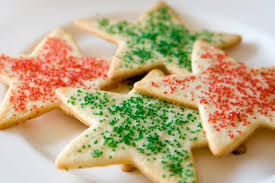Christmas Cookies
Cakes of all shapes and sizes (including smaller items such as cookies) have been part of festive holiday rituals long before Christmas. Ancient cooks prepared sweet baked goods to mark significant occasions. Many of these recipes and ingredients (cinnamon, ginger, black pepper, almonds, dried fruits etc.) were introduced to Europe in the Middle Ages. They were highly prized and quickly incorporated into European baked goods. Christmas cookies, as we know them today, trace their roots to these Medieval European recipes. Dutch and German settlers introduced cookie cutters, decorative molds, and festive holiday decorations to America. Dutch New Year’s cookies were also sometimes molded into fancy shapes. German lebkuchen (gingerbread) was probably the first cake/cookie traditionally associated with Christmas. Sugar cookie type recipes descended from English traditions. Did you know Animal crackers began as edible ornaments?
“By the 1500s, Christmas cookies had caught on all over Europe. German families baked up pans of Lebkuchen and buttery Spritz cookies. Papparkakor (spicy ginger and black-pepper delights) were favorites in Sweden; the Norwegians made krumkake (thin lemon and cardamom-scented wafers). The earliest Christmas cookies in America came ashore with the Dutch in the early 1600s.”
—“America’s Best Holiday Cookies,” McCall’s [magazine], December 1994 (p. 85)
The flood of cheap imported wares form Germany between 1871 and 1906 when the import laws were changed, inundated our Christmas markets with cooking utensils like…cookie cutters…Unlike homemade counterparts, or local tinsmith’s wares, these tools depicted highly stylized images, often frawn from secular themes or…with subjects designed specifically to hang on the Christmas tree. Likewise, recipes appeared in popular cookbooks to better match the demands of such utensils…In a sense, with the advent of inexpensive tin cutters, new emphasis was placed on shape, where in the past, many homemade cookies simply had been square or round. Bells, Christmas trees, camels, crimped wares (cutters with zigzag edges), lilies, Sant Clauses, turkeys, all of these elaborate shapes tended to deemphasize texture and flavor.”
—The Christmas Cook: Three Centuries of American Yuletide Sweets, William Woys Weaver [Harper Perennial:New York] 1990 (p. 106)




Leave a Reply
Want to join the discussion?Feel free to contribute!